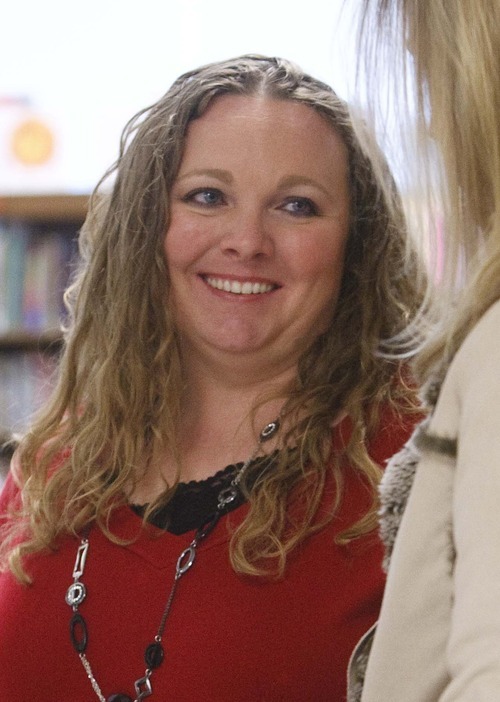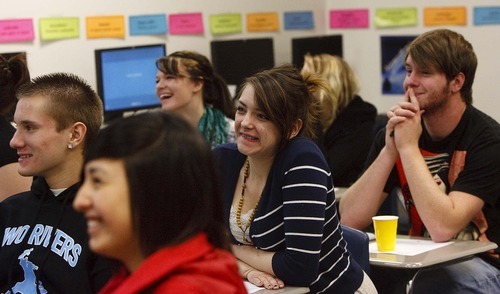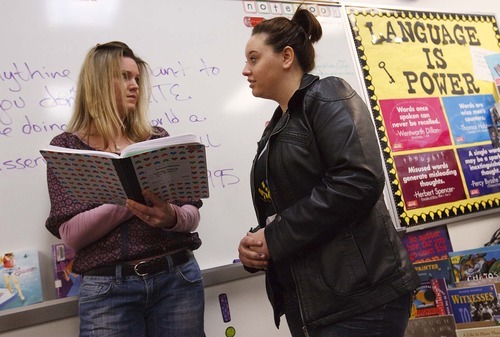This is an archived article that was published on sltrib.com in 2012, and information in the article may be outdated. It is provided only for personal research purposes and may not be reprinted.
People often think of alternative high schools as places where students go to earn diplomas when traditional high schools don't fit.
But at Two Rivers High, an alternative school in Ogden, students in teacher Cassie Cox's class spent the semester doing much more than just trying to earn diplomas. They spent months writing novels and stories, often in hopes of getting published. Once a week, two published authors visited the class to give the teens tips and feedback, thanks to a grant from the Utah Education Association (UEA) Children at Risk Foundation.
It made a difference for the students, some of whom had nearly given up on school.
"Before I thought no one even saw any potential in me, but then Mrs. Cox was like, 'You are a good writer. You have so much going for you,' " said senior Shailee Bettis of her teacher, who applied for the UEA foundation grant in hopes of helping inspire her kids. "That made me think I could be something."
It's just one of a number of ways UEA says it is working to help kids — not just teachers and institutions, as the union's foes often claim. UEA leaders have said they felt teachers and the group were targeted during last year's legislative session. They're hoping for more collaboration with lawmakers this year, though it can be hard to predict what might be in store.
"I remain hopeful that we will be able to sit down together and look at public education in our state and move it forward," said UEA president Sharon Gallagher-Fishbaugh.
In some ways, it looks as though the 18,000-member strong union might be in for a slightly gentler time. Sen. Howard Stephenson, R-Draper, recently said he no longer plans to run bills to limit collective bargaining this session.
And freshman Sen. Aaron Osmond, R-South Jordan, is working on a bill that could make changes to teacher employment. But after hearing from teachers across the state, he said he's moving away from the original idea of at-will employment contract models for teachers — a proposal that drew teachers' ire. Instead, he now hopes to focus his bill on performance and accountability for teachers and administrators.
"I felt that true reform can't happen if the stakeholders involved all don't buy into the importance of those reforms, and I felt that the at-will contract model created too much negative feeling from our educators and teachers, that they weren't being valued," Osmond said.
Osmond, who will hold a powerful position as chairman of the Senate Education Committee this session, said he's not out to undermine any organization. He said to make progress, all parties interested in education — the UEA, the state school board and the Legislature — must change.
"Whether it's reality or not, that perception exists that there has been this challenging relationship between the Legislature and [state school] board, the UEA and the Legislature, and vice versa," Osmond said. "Everyone has felt beat up, and that's not productive in any business setting."
That attitude of collaboration has been commended by Gallagher-Fishbaugh, and by other lawmakers.
"I think Sen. Osmond is the first person in my memory as a Republican in a position of power who has really listened and seems willing to take that into account," said Rep. Carol Spackman Moss, D-Holladay.
Moss, a former teacher and UEA member, said last session "UEA became the whipping boy, if you will, or scapegoat for everything that's wrong in education." She's hopeful that won't happen again this session but given recent history, Moss said she would be pleasantly surprised if that's the case.
—
Who does UEA represent? • Many remain wary of the union, which some feel has been an impediment to education reform in Utah.
Stephenson said he doesn't see legislation passed last session as limiting the UEA's power.
Last year, lawmakers passed a number of bills that some felt targeted the UEA, including one that prohibited teacher layoffs based on seniority; a bill to prohibit school districts from paying teachers on leave for union duties; a bill that removed a provision from a then-existing law requiring districts to provide educators who received poor evaluations "reasonable assistance to improve"; and a bill to allow union members to withdraw from their unions and stop paycheck dues deductions at any time during the year, though UEA leaders said that was already allowed.
Stephenson said he saw those bills as "increasing the power of teaching professionals."
"I think you will see a concerted effort on the part of the Legislature to build greater working relationships with teaching professionals," Stephenson said of the coming session. "That may or may not include the union because often the union's proposals are counter to what the best teaching professionals support."
Judi Clark, executive director of Parents for Choice in Education, which supported those bills, said the UEA represents its members, not kids.
"The Legislature has made really tough decisions in tough economic times and they have always been solid on doing what's best for Utah students, and if the union feels like that didn't swing in their favor ... then I think that's just telling," Clark said of last session. "I guess now we know the union doesn't really represent kids."
Not surprisingly, UEA leaders and supporters disagree.
The undertaking at Two Rivers High is just one of a number of UEA-affiliated projects around the state. The foundation has also given grants to a Monument Valley teacher to take his students on college visits. And the UEA worked with the National Education Association and Salt Lake Teachers Association to fund a Priority Schools project at Salt Lake City's Glendale Middle School.
As part of the project, school board members, the superintendent, administrators, teachers and parents are working together to improve the school, which has struggled with achievement.
Also, Gallagher-Fishbaugh said the UEA hopes to partner with a lawmaker to run legislation this session to create peer assistance review panels of teachers and administrators. Master teachers would work with teachers new to the profession or deemed in need of remediation and then make recommendations to a panel on whether those teachers need more help, are ready to move on to the next level of their careers or should go.
Gallagher-Fishbaugh called it a "unique" approach.
Cox, the Two Rivers High teacher, said she believes the UEA is working to help kids in her classroom and elsewhere, despite what others may say.
"We all are going to have personal stories and opinions toward the UEA," Cox said. "I feel like the UEA, when they fight for teachers, they're fighting for students. When they're fighting for us, that's a fight to make everything better for students because we represent our students. We work for our students."
Utah teachers groups
The Utah Education Association is the state's largest teachers' union, with more than 18,000 members. The state also has an American Federation of Teachers affiliate, AFT Utah, and non-union professional associations for educators.







